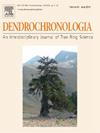Variation in radial growth sensitivity to drought among genetic groups of common yew (Taxus baccata L.) in central Italy
IF 2.7
3区 农林科学
Q1 FORESTRY
引用次数: 0
Abstract
Common yew (Taxus baccata L.) is a long-living European species, with significant ecological importance. Climate change and severe droughts threaten its growth, emphasizing the need for preserving genetic diversity. By combining dendroecology and genetics, we aimed to identify groups of trees most resilient to changing climatic conditions. We analysed radial growth trends from 1951 to 2018 in three populations located in two mountain areas of central Italy with different rainfall regimes. From 298 selected yew trees, needles were collected for DNA extraction, and tree-ring cores were obtained for dendrochronological analysis. We assessed the relationship between tree growth and drought using the Standardized Precipitation Evapotranspiration Index (SPEI). The studied populations clustered in two distinct genetic groups, corresponding to the driest and wettest areas. At the rainiest site, in the period 1951–2018 yew growth was less constrained by evapotranspiration rates than at the driest area, but climate-growth analysis on moving windows indicates an increasing impact of drought. Growth recovery time after the 2003 drought was longer in individuals at the rainiest area compared to the more xeric sites. The yew trees of the driest area, which were further subdivided in two genetically distinct but spatially intermingled sub-groups, appeared to be better adapted to drought events and therefore more suitable for future warmer scenarios. This study highlights the climate sensitivity of common yew, showing that summer droughts can limit growth, and suggests the advantages of using a dendrogenetic approach to delve deeper into ecophysiological responses to be exploited for reforestation and conservation efforts.
意大利中部普通红豆杉(Taxus baccata L.)遗传群间径向生长对干旱敏感性的差异
红豆杉(Taxus baccata L.)是一种长寿的欧洲物种,具有重要的生态意义。气候变化和严重干旱威胁着它的生长,强调了保护遗传多样性的必要性。通过结合树木生态学和遗传学,我们的目标是确定最能适应气候变化的树木群体。我们分析了1951年至2018年意大利中部两个不同降雨量山区三个人口的径向增长趋势。从298棵紫杉树中采集针叶进行DNA提取,获得年轮核进行树木年代学分析。我们利用标准化降水蒸散指数(SPEI)评估了树木生长与干旱的关系。研究的种群聚集在两个不同的遗传群体中,对应于最干燥和最潮湿的地区。在1951-2018年多雨地区,与最干旱地区相比,红豆杉生长受蒸散速率的限制较小,但对移动窗口的气候生长分析表明,干旱的影响越来越大。2003年干旱后,多雨地区的个体生长恢复时间比干旱地区的个体长。最干旱地区的红豆杉被进一步细分为两个遗传上不同但空间上混杂的亚群,它们似乎能更好地适应干旱事件,因此更适合未来更温暖的情景。这项研究强调了普通红豆杉的气候敏感性,表明夏季干旱会限制其生长,并提出了使用树木遗传学方法深入研究生态生理反应的优势,可用于重新造林和保护工作。
本文章由计算机程序翻译,如有差异,请以英文原文为准。
求助全文
约1分钟内获得全文
求助全文
来源期刊

Dendrochronologia
FORESTRY-GEOGRAPHY, PHYSICAL
CiteScore
5.50
自引率
13.30%
发文量
82
审稿时长
22.8 weeks
期刊介绍:
Dendrochronologia is a peer-reviewed international scholarly journal that presents high-quality research related to growth rings of woody plants, i.e., trees and shrubs, and the application of tree-ring studies.
The areas covered by the journal include, but are not limited to:
Archaeology
Botany
Climatology
Ecology
Forestry
Geology
Hydrology
Original research articles, reviews, communications, technical notes and personal notes are considered for publication.
 求助内容:
求助内容: 应助结果提醒方式:
应助结果提醒方式:


